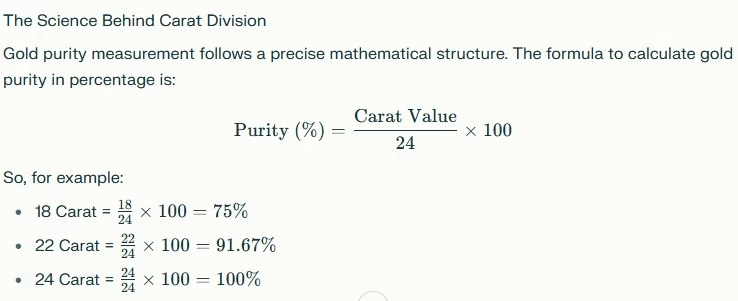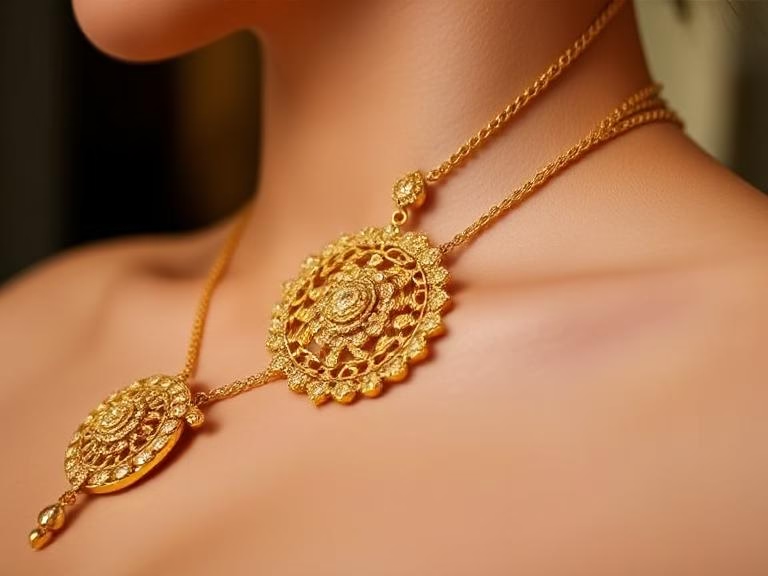Why Is Gold Available Only in 18, 22, or 24 Carats — Not in 19, 21, or 25 Carats?
Gold has always been a symbol of wealth, purity, and prosperity. From traditional Indian weddings to festive occasions, gold plays an integral role in the country’s culture and economy. Whether it’s an ornament adorning the bride or a coin treasured for investment, gold represents timeless value and emotional connection. Yet, one question continues to intrigue many buyers — why is gold available only in 18, 22, and 24 carats, and not in 19, 21, or 25 carats?
Understanding the answer requires exploring how gold is measured, its purity levels, alloy compositions, and the standards set by international and Indian authorities such as the Bureau of Indian Standards (BIS). In this detailed guide, we will explore these aspects step-by-step to clarify why only specific carat values are officially recognized and traded.
What Does “Carat” Mean in Gold?
The term carat (or karat, as used in some regions) defines the purity of gold. It indicates the proportion of pure gold present in an alloy out of 24 parts. In other words, pure gold is classified as 24 carats. Each carat unit represents one part of pure gold out of 24.
-
24 Carat Gold = 24/24 parts pure = 100% pure gold
-
22 Carat Gold = 22/24 parts pure = approximately 91.67% pure
-
18 Carat Gold = 18/24 parts pure = approximately 75% pure
Gold in its natural, pure form (24 carats) is extremely soft and malleable. If you try to make jewelry from pure 24-carat gold, it can easily bend, scratch, or lose shape. To make gold durable enough for everyday wear, metals like copper, silver, nickel, or zinc are added. This mixing process creates various carat variations based on the percentage of pure gold retained.
Why Pure 24-Carat Gold Is Not Always Practical
While 24-carat gold symbolizes purity, it’s not suitable for all types of use — especially for jewelry that needs to withstand daily wear and tear. Pure gold is soft and prone to deformation, so jewelers mix it with harder metals to increase its strength and durability.
-
Softness: 24-carat gold can be easily scratched or bent.
-
Workability: It’s difficult to craft intricate jewelry designs with pure gold.
-
Durability: 24-carat gold jewelry loses shape over time.
Hence, 22-carat gold, containing 22 parts of gold and 2 parts of other metals, becomes the most preferred choice for making traditional jewelry in India. It offers both purity and strength. On the other hand, 18-carat gold, with 75% gold content, is ideal for contemporary designs and heavy ornaments where durability matters more than purity.
The Science Behind Carat Division
Gold purity measurement follows a precise mathematical structure. The formula to calculate gold purity in percentage is:
 This uniform scale ensures that the ratio of metals in any gold alloy remains consistent and recognized globally.
This uniform scale ensures that the ratio of metals in any gold alloy remains consistent and recognized globally.
However, not every value between 1 and 24 is practical or used commercially. Some ratios do not create stable or aesthetically pleasing alloys, while others do not adhere to established hallmarking and standardization systems.
Then Why Not 19, 21, or 25 Carat Gold?
Many wonder why jewelers or refineries don’t offer 19, 21, or even 25-carat gold. The answer lies in international standardization and hallmarking norms. Gold purity must be measured, tested, and certified according to fixed benchmarks to ensure consistency, authenticity, and consumer protection.
In India and several other countries, the Bureau of Indian Standards (BIS) regulates the types of gold purity that can be officially hallmarked and sold. The BIS has approved hallmarking for specific purity levels only, such as:
-
14 Carat (58.3% purity)
-
18 Carat (75% purity)
-
22 Carat (91.67% purity)
-
24 Carat (99.9% purity)
These specific levels were chosen because they balance manufacturing feasibility, purity, and market demand. Each of these alloys has stable properties suitable for practical use — from coins and bars to jewelry and investment products.
Creating ratios like 19 or 21 carats would make quality control harder, confuse consumers, and disrupt existing global norms. Additionally, 25-carat gold would technically exceed the purity of natural gold (which is impossible since 24 carats represent absolute purity).
The Role of BIS and Hallmarking in Gold Standardization
The Bureau of Indian Standards (BIS) is the official authority that certifies and monitors gold purity across India. It has set benchmark purities to ensure that buyers receive exactly what they pay for. Under the hallmarking system:
-
Hallmark certification guarantees the purity of gold.
-
It includes the BIS logo, purity in carats or fineness number, jeweler’s identification mark, and hallmarking center ID.
-
Only gold jewelry made in 14K, 18K, and 22K varieties is eligible for official hallmarking.
This hallmark acts as a verified promise of quality. By limiting the recognized carat purities to certain values, the BIS prevents fraud and ensures quality uniformity across the market.
Why 22-Carat Gold Dominates the Indian Market
In India, 22-carat gold is the most commonly used variety for jewelry. It strikes a perfect balance between purity, strength, and shine — making it ideal for bangles, necklaces, and earrings. The small percentage of alloy metals enhances its hardness without compromising its radiant yellow hue.
Key reasons behind 22K gold’s popularity:
-
Traditional preference and cultural trust.
-
Ideal for crafting elaborate Indian designs.
-
Maintains high resale and exchange value.
-
Approved BIS standard ensures authenticity.
By contrast, 18-carat gold suits modern, sleek designs often seen in western jewelry or diamond settings where structure and durability are more important than purity. Meanwhile, 24-carat gold is mostly used for coins, bars, and investment products due to its extreme softness.
Global Perspective on Gold Carat Standards
Gold carat systems are recognized worldwide, though the most common grades remain almost identical across major economies. Below is a quick comparison of gold types and their uses globally:
| Carat | Purity (%) | Common Usage | Durability | Region Popularity |
|---|---|---|---|---|
| 24K | 99.9% | Coins, bars, bullion | Very soft | Global |
| 22K | 91.67% | Jewelry (India, Middle East) | Moderate | Asia, Middle East |
| 18K | 75% | Fine jewelry, watches | Strong | Europe, US |
| 14K | 58.3% | Daily wear jewelry | High | Western countries |
| 10K | 41.7% | Budget jewelry | Very strong | North America |
Values like 19K or 21K are rare because the differences in color, hardness, and purity do not justify separate manufacturing standards. Maintaining uniform carat levels simplifies trade, certification, and consumer understanding.
Understanding Fineness Number Alongside Carats
Besides carats, another method to express gold purity is the fineness number — a three-digit figure stamped on the jewelry. It signifies the parts of pure gold per thousand parts of total alloy. For example:
-
24K = 999 or 995 fineness
-
22K = 916 fineness
-
18K = 750 fineness
-
14K = 585 fineness
So, the next time you see jewelry labeled with “916,” it indicates 22-carat purity. The fineness system offers precise numerical detail, complementing the traditional carat terminology.
How Alloying Metals Affect Gold Color and Strength
Adding other metals to gold not only increases its hardness but can also change its color tone. This results in various charming shades used in jewelry today:
-
Yellow Gold: Pure gold mixed with small amounts of silver and copper.
-
White Gold: Gold combined with metals like palladium or nickel and coated with rhodium for shine.
-
Rose Gold: Gold blended with a higher ratio of copper, giving a pinkish hue.
By controlling the alloy proportions, jewelers can craft diverse looks while maintaining the recognized carat values (14K, 18K, 22K).
Why Official Carat Standards Ensure Consumer Trust
If every jeweler started creating arbitrary carat purities (like 19K or 21K), buyers would face uncertainty about authenticity, pricing, and resale value. Official carat standards backed by hallmarking provide:
-
Transparency: Buyers know exactly how pure the gold is.
-
Uniform Pricing: Carat-based pricing simplifies transactions.
-
Global Recognition: Uniform standards help with international trade.
-
Consumer Confidence: Hallmarked gold assures purity verification.
For these reasons, both the Indian and international gold markets adhere strictly to approved carat levels.
Summary: The Logic Behind 18K, 22K, and 24K Gold
Gold is categorized into specific carat grades to maintain purity, durability, and standardization. The three main varieties — 18K, 22K, and 24K — serve distinct purposes:
-
18 Carat Gold (75%): Ideal for designer and diamond-studded jewelry due to durability.
-
22 Carat Gold (91.67%): Perfect for traditional jewelry, balancing purity and strength.
-
24 Carat Gold (99.9%): Reserved for gold coins, bars, and investments.
Values like 19K, 21K, or 25K are not recognized because they lack regulatory acceptance, practical balance, and market demand. The Bureau of Indian Standards (BIS) only certifies hallmarking for specific carats to preserve trust and consistency.
Final Thoughts
Gold continues to be the heartbeat of Indian tradition and investment culture. Whether gifted during festivals or held as a long-term asset, its brilliance never fades. However, understanding the logic behind carat grading — especially why gold is available only in 18, 22, or 24 carats — empowers buyers to make informed and confident purchases.
The next time you buy a gold ornament, look for the BIS hallmark and carat marking. It’s not just a stamp — it’s a promise of purity, trust, and timeless value.
for more article visit BulletinBuzzs
